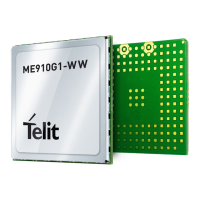ME910G1 Hardware Design Guide
1VV0301593 Rev.12 Page 30 of 93 2021-09-24
• A low ESR Bypass capacitor of adequate capacity must be provided to stop the
current absorption peaks. The recommended capacitor is a 100μF tantalum.
• Make sure the low ESR capacitor (usually a tantalum one) is rated at least 10V.
• A protection diode must be placed near the power input. This protects the
ME910G1 from power polarity inversion. Otherwise, the battery connector must be
specifically designed to avoid polarity inversions when connecting the battery.
• The battery must be rated to supply peaks of current up to 2A.
Note: DO NOT USE any Ni-Cd, Ni-MH, and Pb battery types directly
connected with ME910G1. Their use can lead to overvoltage on the
ME910G1 and damage it. You can use LI-Ion, Li-Po, Li-FePO4
secondary batteries or hi current Lithium primary batteries.
Thermal Design Guidelines
Worst case as reference values for thermal design of ME910G1 are:
• Average current consumption: 700 mA (LTE CAT M1 and NB1 modes)
• Average current consumption: 700 mA (GPRS and EDGE modes)
• Supply voltage: 4.50V
Note: Make the PCB design to have the best connection of GND pads
to large copper surfaces.
Note: The ME910G1 includes a function to prevent overheating.
Power Supply PCB Layout Guidelines
As seen in the electrical design guidelines, the power supply shall have a low ESR
capacitor on the output to cut the current peaks on the input to protect the supply from
spikes. The placement of this component is essential for the correct working of the
circuitry. A misplaced component can be useless or can even decrease the performance
of the power supply.
• The low ESR Bypass capacitor must be placed near the Telit ME910G1 power input
pads or, if the power supply is of the switching type, it can be placed near to the
inductor to cut the ripple provided that the PCB trace from the capacitor to the

